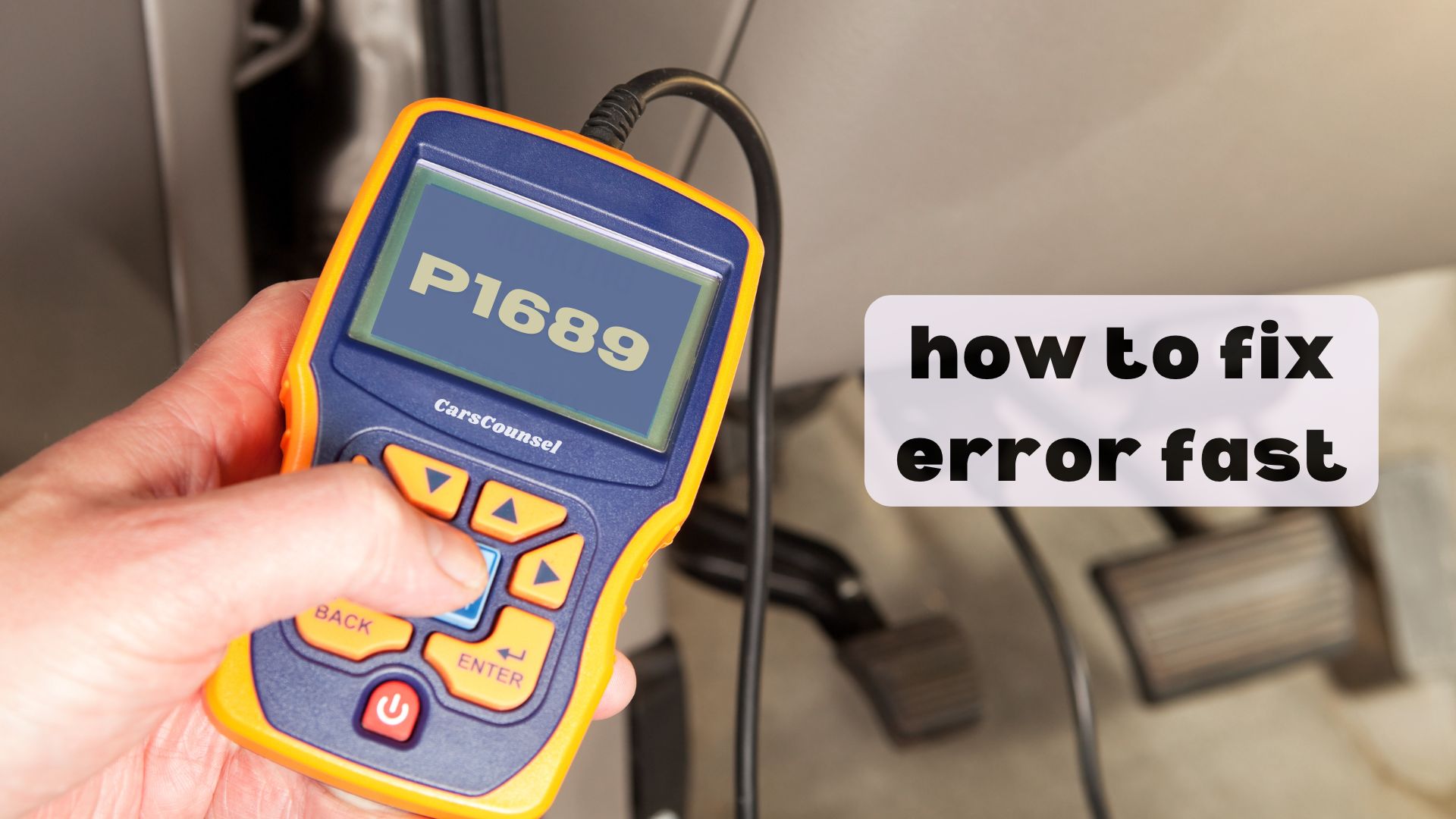As you diagnose the issues plaguing your vehicle, you stumble upon the P1689 code, indicating a breakdown in communication between the Engine Control Module (ECM) and Injection Pump Module Data.
This disruption can manifest in various performance problems, from rough idling to engine stalling. But what’s causing this critical failure?
Is it a faulty connection, module malfunction, or software glitch? To get to the root of the issue, you’ll need to dig deeper and investigate the complex relationship between these two essential systems.

Quick Navigation
Key Takeaways
- The P1689 code is triggered when the ECM and Injection Pump Module Data fail to communicate, affecting fuel delivery and engine operation.
- Faulty connections, module malfunctions, corrosion, and software issues can cause the P1689 code, leading to poor engine performance and reduced fuel efficiency.
- Symptoms of a faulty communication include rough idling, fuel inefficiency, engine stalling, and the illumination of the Check Engine Light.
- To resolve the issue, inspect wiring and connections, test fuel injector performance, and check for corrosion or damage to electrical connections.
- Post-repair testing involves disconnecting the battery, waiting 30 minutes, and reconnecting to restart the ECM and re-establish communication.
Code Overview and Background
When your diesel engine vehicle’s Engine Control Module (ECM) and Injection Pump Module Data fail to communicate effectively, the P1689 code is triggered, indicating a critical issue that can significantly impact your vehicle’s performance.
This communication breakdown affects fuel delivery and engine operation, leading to performance problems. The ECM and Injection Pump Module Data must work together seamlessly to guarantee your diesel engine runs smoothly.
If left unaddressed, the P1689 code can cause a range of issues, including poor engine performance, reduced fuel efficiency, and engine stalling.
Causes of the P1689 Code
Your vehicle’s P1689 code is triggered due to a communication breakdown between the Engine Control Module (ECM) and Injection Pump Module Data, but what’s behind this issue?
Faulty connections between the two modules can be the culprit, causing a disruption in data transmission. Module malfunctions, such as a malfunctioning ECM or Injection Pump Module, can also lead to this fault code.
Additionally, corrosion or damage to electrical connections and software issues affecting communication between modules can trigger the P1689 code.
Identifying the root cause is vital to resolving the issue and restoring proper engine performance.
Symptoms of a Faulty Communication
If you’re experiencing issues with your diesel engine vehicle, it’s likely that a faulty communication between the Engine Control Module (ECM) and the Injection Pump Module Data is to blame.
You may notice rough idling, as the engine struggles to maintain a steady pace. Fuel inefficiency is another common symptom, as the vehicle’s engine misfires or runs rough, leading to reduced fuel efficiency.
Additionally, you might experience engine stalling or hesitation, and the Check Engine Light may illuminate on your dashboard. These symptoms indicate a faulty communication between the ECM and Injection Pump Module Data.
Diagnostic and Repair Steps
To diagnose and repair the P1689 code, you’ll need to follow a systematic approach to identify the root cause of the communication issue between the Engine Control Module (ECM) and the Injection Pump Module Data. This will help you pinpoint the problem and get your diesel engine running smoothly again.
| Step | Action |
|---|---|
| 1 | Inspect wiring and connections between ECM and Injection Pump Module |
| 2 | Test fuel injector performance for proper diesel performance |
| 3 | Check for corrosion or damage to electrical connections |
| 4 | Reset the ECM to clear the code and re-establish communication |
| 5 | Test drive the vehicle to guarantee proper communication and engine performance, then verify to confirm that the issue is resolved. |
Inspecting and Testing the ECM and Injection Pump Module
The Engine Control Module (ECM) and Injection Pump Module are critical components that must communicate effectively to guarantee proper engine operation.
When a P1689 code is triggered, it’s essential to inspect and test these modules to identify the root cause of the issue. Start by performing a thorough wiring inspection to rule out any corrosion, damage, or faulty connections.
Check for signs of Module Failure, such as burn marks, rust, or physical damage. Use a multimeter to test the voltage and resistance of the wiring and connections.
This will help you determine if the issue lies within the ECM, Injection Pump Module, or the wiring itself.
Resetting the ECM and Re-establishing Communication
Once you’ve completed the inspection and testing of the ECM and Injection Pump Module, it’s time to reset the ECM and re-establish communication between the two modules. This process will clear the P1689 code and allow the modules to communicate effectively.
| Step | Action | Result |
|---|---|---|
| 1 | Disconnect the battery | Erase ECM memory |
| 2 | Wait 30 minutes | Allow ECM to fully discharge |
| 3 | Reconnect the battery | ECM restarts and reboots |
| 4 | Clear the P1689 code | Communication re-established |
Post-Repair Testing and Verification
After resetting the ECM and re-establishing communication with the Injection Pump Module, you’ll want to verify that the P1689 code has been successfully cleared and the engine is operating as expected.
To do this, follow test drive protocols to guarantee the engine is running smoothly and efficiently.
Perform fuel system checks to confirm proper fuel delivery and pressure.
Monitor the dashboard for any warning lights or error messages.
If the engine is performing as expected, you can be confident that the P1689 code has been successfully cleared and the communication issue has been resolved.
Additional Resources and Next Steps
You’ll need reliable resources to guarantee the P1689 code repair is done correctly and efficiently.
To certify a successful repair, consider the following:
- Get accurate Repair Estimates: Consult with a trusted auto repair shop for a more accurate estimate based on your vehicle make and model.
- Access Factory Manuals: Get access to Factory Service Manuals for more information on how to fix the P1689 code.
- Find a trusted repair shop: Find a repair shop in your area to get the P1689 code diagnosed by a professional.
These resources will help you navigate the repair process and verify your vehicle is running smoothly again.
More OBD-II Codes
| P1691 | P1695 | P1155 | P1156 |
| P1157 | P1158 | P1159 | P1161 |
| P1163 | P1164 | P1165 | P1170 |
| P1171 | P1185 | P1189 | P1187 |
| P1190 | P1215 | P1216 | P1217 |
| P1218 | P1219 | P1220 | P1228 |
Frequently Asked Questions
Can I Drive My Vehicle With a P1689 Code?
You can drive your vehicle with a P1689 code, but be aware that it may lead to reduced fuel efficiency and compromised vehicle performance, potentially causing misfires, stalling, or hesitation, so it’s essential to address the issue promptly to avoid further damage.
Will a Tune-Up Fix the P1689 Code Issue?
You’re wondering if a tune-up can fix the issue, but the truth is, a tune-up won’t address faulty connections or fuel system issues causing the problem. You’ll need to inspect and repair wiring, test modules, and reset the ECM to resolve the issue.
Can I Repair the P1689 Code Myself?
You can attempt to repair the issue yourself, but it’s vital to thoroughly inspect the wiring harness and fuel injector connections, ensuring no corrosion or damage, before resetting the ECM to re-establish communication and testing the system.
Will a New ECM Fix the P1689 Code?
As you navigate the complex landscape of engine repair, a new ECM might seem like a silver bullet, but it’s not a guarantee to fix the issue; a thorough diagnosis and potentially a Module reflash or ECM replacement might be necessary to reestablish communication.
Can the P1689 Code Cause Permanent Engine Damage?
You risk permanent engine damage if you ignore the P1689 code, as it can lead to repeated engine stalling, causing excessive fuel pump pressure and potentially seizing your engine, so address the issue promptly to avoid costly repairs.
Conclusion
As you navigate the repair journey, keep in mind that resolving the P1689 code is like untangling a complex web – each thread represents a potential culprit, and patience is key to weaving them back into harmony. By meticulously following the diagnostic and repair steps, you’ll be able to re-establish the vital connection between the ECM and Injection Pump Module, and your engine will roar back to life, much like a conductor orchestrating a symphony.

